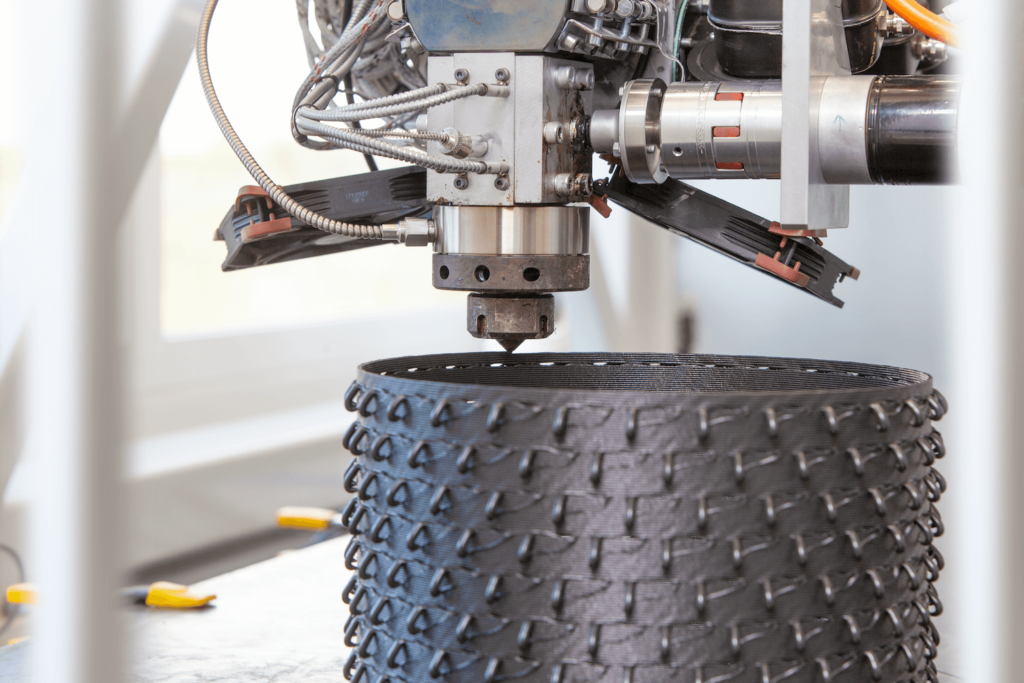The story behind the world’s largest mobile 3D printer
Furniture made from plastic waste using a 3D printer. Sounds fascinating, doesn’t it? What makes it even more impressive is that this printer can print objects up to 3 metres long and 1.5 metres high 50 times faster than its competitors. And it has been integrated into a container so that it can travel around the world. Over the past thirty years, we’ve had the opportunity as a machine builder to work on several special projects, but this mobile 3D printer must be one of the most fascinating devices ever. We spoke to Philippe Merillet, one of the founders of the 3D start-up Colossus.
“My parents work for NGOs, so they used to take me all over the world,” says Philippe. “I think the seed for Colossus was planted as early as my childhood. In India, millions of people live in huge rubbish dumps. They collect plastic rubbish and get money for it”.
We rewind back to four years ago. “I was a worker in a big company… and boredom started to strike. I needed a new challenge. It had always been my dream to do something for the environment by giving waste a second life. I was inspired by an American who recycled cigarette filters for hotel chains and restaurants. He took the plastic out of the cigarette butts, made ashtrays and other gadgets with them and sold them back to those chains. And anyone who gets the Americans to recycle is a hero as far as I am concerned. I am talking about Tom Szaky, the founder of the successful recycling company Terra Cycle”.
“Existing technology was either too slow, not good enough or too expensive.
Philippe Merillet, CEO Colossus
“I also wanted to recycle waste, but using the technology of 3D printers, which were very popular at the time. I became fascinated by the new possibilities offered by this technology. But there were two problems: I did not know anything about 3D printing, and there were no PET filaments on the market”. The best way to compare a filament is with the ink cartridge of a standard printer: it is the ink of a 3D printer.
“That was the start of our start-up. Our first mission? To find out how we could extrude filaments. Once we figured that out, we started selling small, printed gadgets. One of our first customers was the Belgian festival Pukkelpop, where we recycled plastic cups”.
“But then we were presented with a new challenge. Printing gadgets is cool, but can you also make furniture? That’s when 3D expert Yannick joined us. Before joining us, he worked for a company that sold filaments and 3D printers. That’s why we decided to give it a try. Because we had already mastered the extrusion process, all we had to do was buy the right printing technology. Or so we thought.
“Our mobile 3D printer is going to make small production runs financially viable.
Philippe Merillet, CEO Colossus
“We sent our filament to several 3D printing companies, accompanied by one job: print a chair. In search of a solution, we travelled all over Europe. We even ended up in the north of Sweden. They serve moose burgers there, just to make clear how northerly we were. But it all turned out to be a fiasco. The technology was just not good enough. The solutions proposed were either too slow or would have cost us a fortune.
“We can’t buy it? Then we’ll make our own mobile 3D printer!” That was Yannick’s idea. I told him he was crazy. What did we know about building a printer? Let alone a mobile 3D printer. That’s why we no longer went looking for 3D printing companies, but turned our attention to machine builders. Then VINTIV came into the picture.”
“With them at our side, all the pieces of the puzzle were there. They knew everything about mechanics, linear and safety functions, the actual building process and programming software. We on the other hand, had experience in extrusion and printing processes”.

“We knew what we wanted. It had to be a container. The mobile 3D printer had to be able to print objects of that size. But we had no idea of the possibilities. That’s why we asked VINTIV to study everything, so that we could get a clear view of the feasibility, the budget and the timing. That would help us to convince investors. No one would take our story seriously without a good preparation”.
“It was a real rollercoaster. And to be honest, it still is. We can finally show a working prototype of our mobile 3D printer to the world. Now it all comes down to testing it, refining it, making it better and adding extra features. We have 3 working machines installed over the world. We hope that our printers will change the way furniture designers work. Now you have to buy mass-produced furniture We want to put an end to that. Small production runs need to become financially viable.
“My ultimate goal is to use these mobile 3D printers in Africa and Asia as well, so that the waste can be recycled directly there and we can improve the quality of life. That is why I am doing what I am doing. I want to have an impact on people’s lives. And improve lives.”